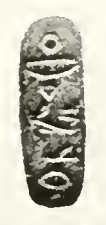Top Qs
Timeline
Chat
Perspective
Nebmaatre
Egyptian pharaoh From Wikipedia, the free encyclopedia
Remove ads
Nebmaatre is the prenomen of a poorly attested ruler of the late Second Intermediate Period of Ancient Egypt. Nebmaatre may have been a member of the early 17th Dynasty and as such would have reigned over the Theban region.[3] Alternatively, Jürgen von Beckerath believes that Nebmaatre was a ruler of the late 16th Dynasty.[4][5]
Remove ads
Attestations

The prenomen Nebmaatre is attested on a bronze axe-head discovered in a tomb at Mostagedda in Middle Egypt and now in the British Museum under the catalog number BM EA 63224. The same prenomen is inscribed on a black steatite amulet representing a lion of unknown provenance and now in the Petrie Museum under the catalog number 11587.[1] A degree of uncertainty affects the ownership of these artifacts since Amenhotep III's prenomen was Nebmaatre as well. However, the axe-head can be dated to the late Second Intermediate Period based on stylistic grounds and provenance while according to Flinders Petrie the amulet is of too rough a workmanship to be attributable to Amenhotep III.[6][7] Instead, Petrie suggested that the amulet be attributable to Ibi, an obscure ruler of the late 13th Dynasty whose prenomen is partially preserved in the Turin canon as "[...]maatre". However, Kim Ryholt's recent study of the Turin canon precludes this identification as a vertical stroke in the lacuna just prior to "maatre" rules out the hieroglyph for "neb".[6]
Remove ads
Chronological position
The chronological position of Nebmaatre in the Second Intermediate Period is highly uncertain. The Egyptologist Jürgen von Beckerath proposes that Nebmaatre was a ruler of a compounded 15th–16th Dynasty, which he sees as an entirely Hyksos line of kings.[8] Alternatively, Kim Ryholt put forth the hypothesis that Nebmaatre was a king of the 17th Dynasty, although he left his position in the dynasty unspecified. [9] Ryholt's datation is based on the observation that the axe-head bearing Nebmaatre's name was found in a tomb belonging to the Pan-Grave culture.[10][6] Egyptologist Darrell Baker points out that the Theban rulers of the period might indeed have provided such weapons to their mercenaries.[6]
Remove ads
References
Wikiwand - on
Seamless Wikipedia browsing. On steroids.
Remove ads

